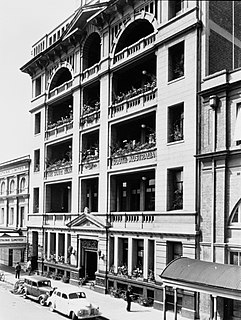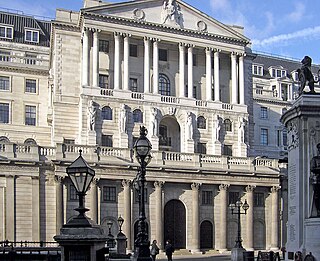
Banking in the United States began by the 1780s along with the country's founding and has developed into highly influential and complex system of banking and financial services. Anchored by New York City and Wall Street, it is centered on various financial services namely private banking, asset management, and deposit security.

The Commonwealth Bank of Australia (CBA), or CommBank, is an Australian multinational bank with businesses across New Zealand, Asia, the United States and the United Kingdom. It provides a variety of financial services including retail, business and institutional banking, funds management, superannuation, insurance, investment and broking services. The Commonwealth Bank is the largest Australian listed company on the Australian Securities Exchange as of August 2015 with brands including Bankwest, Colonial First State Investments, ASB Bank, Commonwealth Securities (CommSec) and Commonwealth Insurance (CommInsure).

The Bank of Queensland is an Australian retail bank with headquarters in Brisbane, Queensland. The bank is one of the oldest financial institutions in Queensland, having begun as a building society. It now has 160 branches throughout Australia, including 65 corporate branches and 95 "owner managed" branches.

The Australia and New Zealand Banking Group Limited (ANZ) is an Australian multinational banking and financial services company headquartered in Melbourne, Victoria. It is Australia's second-largest bank by assets and fourth-largest bank by market capitalisation.
St.George Bank is an Australian bank with its headquarters in Sydney. Since a 2008 merger, the bank has been part of Westpac, having previously been an independent legal entity. In 2010, St.George was deregistered as a company and ceased to be a standalone authorised deposit-taking institution.
Banking in Australia is dominated by four major banks: Commonwealth Bank, Westpac, Australia & New Zealand Banking Group and National Australia Bank. There are several smaller banks with a presence throughout the country, and a large number of other financial institutions, such as credit unions, building societies and mutual banks, which provide limited banking-type services and are described as authorised deposit-taking institutions (ADIs). Many large foreign banks have a presence, but few have a retail banking presence. The central bank is the Reserve Bank of Australia (RBA). The Australian government’s Financial Claims Scheme (FCS) guarantees deposits up to $250,000 per account-holder per ADI in the event of the ADI failing.

The State Bank of South Australia was a bank created in 1896 and owned by the Government of South Australia. The bank became the subject of a two-year South Australian Royal Commission upon collapse in 1991. The surviving part of the bank now exists as BankSA.
A Bank State Branch is the name used in Australia for a bank code, which is a branch identifier. The BSB is normally used in association with the account number system used by each financial institution. The structure of the BSB + account number does not permit for account numbers to be transferable between financial institutions. While similar in structure, the New Zealand and Australian systems are only used in domestic transactions and are incompatible with each other. For international transfers, a SWIFT code is used in addition to the BSB and account number.
HSBC Bank Australia Limited is the Australian subsidiary of HSBC. The bank offers a wide range of financial services in Australia through a network of 36 branches and offices. These services include retail and commercial banking, financial planning, trade finance, treasury and financial markets, payments and cash management and securities custody.
The Big Four is the colloquial name given to the four main banks in several countries where the banking industry is dominated by just four institutions and where the phrase has thus gained relevance. Some countries include more or less institutions in such rankings, leading to other names such as Big Three, Big Five, or Big Six.
The Savings Bank of South Australia was founded in 1848, trading from a single room in Gawler Place, Adelaide. In 1984 it merged with the State Bank of South Australia, with the merged entity taking the latter name. The Bank of South Australia is now a division and a trading name of St.George Bank, which is now a subsidiary of Westpac.
China's banking sector had ¥319.7 trillion RMB in assets at the end of 2020. The "big four/five" state-owned commercial banks are the Bank of China, the China Construction Bank, the Industrial and Commercial Bank of China, and the Agricultural Bank of China, all of which are among the largest banks in the world as of 2018. The Bank of Communications is sometimes included. Other notable big and also the largest banks in the world are China Merchants Bank and Ping An Bank.
A No-Doc or Low-doc loan refers to loans that do not require borrowers to provide documentation of their income to lenders or do not require much documentation. It is a financial product commonly offered by a mortgage lender to consumers who cannot qualify for normal loan products because of fluctuating or hard-to-verify incomes, such as the self-employed, or to serve long time customers with strong credit. Applicants are often required to provide a substantial down payment, i.e. a larger deposit either through equity in security or personal savings.
The four pillars policy is an Australian Government policy to maintain the separation of the four largest banks in Australia by rejecting any merger or acquisition between the four major banks. The policy, rather than formal regulation, first articulated in 1990, reflects the competitive concerns of more concentration as well as the broad political unpopularity of further bank mergers. A number of economically liberalist commentators have argued that the "four pillars" policy is built upon economic fallacies and works against the Australia's better interests.

Westpac Banking Corporation, known simply as Westpac, is an Australian bank and financial services provider headquartered in Sydney, Australia. Established in 1817 as the Bank of New South Wales, it acquired the Commercial Bank of Australia in 1982 before being renamed shortly afterwards. It is one of Australia's "big four" banks and is Australia's first and oldest banking institution. Its name is a portmanteau of "Western" and "Pacific".

A bank is a financial institution that accepts deposits from the public and creates a demand deposit while simultaneously making loans. Lending activities can be directly performed by the bank or indirectly through capital markets.
The New York State Banking Department was created by the New York Legislature on April 15, 1851, with a chief officer to be known as the Superintendent. The New York State Banking Department was the oldest bank regulatory agency in the United States.

ME Bank, also known as ME, is an Australian direct bank based in Melbourne. ME Bank no longer has branches in Sydney, Brisbane, Adelaide, Perth, Hobart, Canberra and Darwin. It became a subsidiary of Bank of Queensland in July 2021.
The Trust Bank of Tasmania was a former state bank operating in Tasmania, Australia. It was created in 1991 from the merger of the Tasmania Bank and Hobart Savings Bank/Savings Bank of Tasmania, until being sold to Colonial Limited in 1999.
The Royal Commission into Misconduct in the Banking, Superannuation and Financial Services Industry, also known as the Banking Royal Commission and the Hayne Royal Commission, was a royal commission established on 14 December 2017 by the Australian government pursuant to the Royal Commissions Act 1902 to inquire into and report on misconduct in the banking, superannuation, and financial services industry. The establishment of the commission followed revelations in the media of a culture of greed within several Australian financial institutions. A subsequent parliamentary inquiry recommended a royal commission, noting the lack of regulatory intervention by the relevant government authorities, and later revelations that financial institutions were involved in money laundering for drug syndicates, turned a blind eye to terrorism financing, and ignored statutory reporting responsibilities and impropriety in foreign exchange trading.








